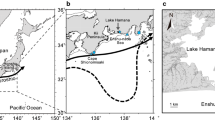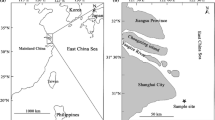Abstract
Predictability of glass eel recruitment of Japanese eel (Anguilla japonica) was examined with a simple indicator constructed using coastal water temperature under the influence of the western boundary current, the Kuroshio. The 1971–2014 glass eel catch from an estuary, Lake Hamana, Japan, was compared with the mean water temperature difference (WTD) between two coastal sites, Shirahama and Lake Hamana, during the glass eel fishing season. The directions of interannual change (i.e., increase/decrease) in the glass eel catch and WTD fully synchronized for 12 consecutive years (1995–2006), and these variables were positively correlated (r = 0.68, p = 0.0150). The WTD was correlated with the southernmost latitude of the Kuroshio path (r = 0.40, p = 0.0068) in the fishing season of the study period (1971–2014); therefore, the WTD appeared to reflect the path fluctuations of the Kuroshio and the warm water intrusions from this western boundary current. The proportion of matching directions between the interannual changes in the glass eel catch and WTD was 0.71 for the non-meander (nearshore) path years (significantly higher than 0.5, the expected proportion of matching signs due to chance; \({\chi }^{2}=2.88\), p = 0.0448), whereas it was 0.46 for the meander (offshore) path years (\({\chi }^{2}=0.15\), p = 0.6526). Thus, the WTD tends to interannually increase/decrease with the estuarine recruitment of A. japonica glass eels when the Kuroshio flows with non-meander paths. This environment-recruitment relationship (western boundary current-recruitment link) in the Japanese eel demonstrates the importance of continuous environmental monitoring of coastal waters.





Similar content being viewed by others
Data Availability
The data supporting the conclusions of this manuscript will be made available by the authors, without undue reservation, to any qualified researcher.
References
Amilhat E, Aarestrup K, Faliex E et al (2016) First evidence of European eels exiting the Mediterranean Sea during their spawning migration. Sci Rep 6:21817. https://doi.org/10.1038/srep21817
Arai K, Itakura H, Yoneta A et al (2019) Anthropogenic impacts on the distribution of wild and cultured Japanese eels in the Tone River watershed, Japan, from otolith oxygen and carbon stable isotopic composition. Environ Biol Fishes 102:1405–1420. https://doi.org/10.1007/s10641-019-00915-1
Béguer-Pon M, Castonguay M, Shan S et al (2015) Direct observations of American eels migrating across the continental shelf to the Sargasso Sea. Nat Commun 6:8705. https://doi.org/10.1038/ncomms9705
Bonhommeau S, Chassot E, Rivot E (2008) Fluctuations in European eel (Anguilla anguilla) recruitment resulting from environmental changes in the Sargasso Sea. Fish Oceanogr 17:32–44. https://doi.org/10.1111/j.1365-2419.2007.00453.x
Chow S, Kurogi H, Mochioka N et al (2009) Discovery of mature freshwater eels in the open ocean. Fish Sci 75:257–259. https://doi.org/10.1007/s12562-008-0017-5
Dekker W (2000) The fractal geometry of the European eel stock. ICES J Mar Sci 57:109–121. https://doi.org/10.1006/jmsc.1999.0562
Drouineau H, Durif C, Castonguay M et al (2018) Freshwater eels: a symbol of the effects of global change. Fish Fish 19:903–930. https://doi.org/10.1111/faf.12300
Durif CMF, Diserud OH, Sandlund OT et al (2020) Age of European silver eels during a period of declining abundance in Norway. Ecol Evol 10:4801–4815. https://doi.org/10.1002/ece3.6234
Fukuda N, Yokouchi K, Yamamoto T et al (2019) Salinity and odor preferences of Japanese eel during the first year of post-recruitment growth in saline water. J Ethol 37:93–99. https://doi.org/10.1007/s10164-018-0572-x
Han Y-S, Tzeng W-N, Liao I-C (2009) Time series analysis of Taiwanese catch data of Japanese glass eels Anguilla japonica: possible effects of the reproductive cycle and El Niño events. Zool Stud 48:632–639
ICES (2019) Joint EIFAAC/ICES/GFCM working group on eels (WGEEL). Copenhagen
Itoh S, Saruwatari T, Nishikawa H et al (2011) Environmental variability and growth histories of larval Japanese sardine (Sardinops melanostictus) and Japanese anchovy (Engraulis japonicus) near the frontal area of the Kuroshio. Fish Oceanogr 20:114–124. https://doi.org/10.1111/j.1365-2419.2011.00572.x
Jessop BM (2020) Oceanic environmental effects on American Eel recruitment to the East River, Chester, Nova Scotia. Mar Coast Fish Dyn Manag Ecosyst Sci 12:222–237. https://doi.org/10.1002/mcf2.10121
Jessop BM, Shiao JC, Iizuka Y (2004) Variation in the annual growth, by sex and migration history, of silver American eels Anguilla rostrata. Mar Ecol Prog Ser 272:231–244. https://doi.org/10.3354/meps272231
Kaifu K, Yokouchi K, Miller MJ, Washitani I (2021) Management of glass eel fisheries is not a sufficient measure to recover a local Japanese eel population. Mar Policy 134:104806. https://doi.org/10.1016/j.marpol.2021.104806
Kasai A, Kimura S, Sugimoto T (1993) Warm water intrusion from the Kuroshio into the coastal areas south of Japan. J Oceanogr 49:607–624. https://doi.org/10.1007/BF02276747
Kim H, Kimura S, Shinoda A et al (2007) Effect of El Niño on migration and larval transport of the Japanese eel (Anguilla japonica). ICES J Mar Sci 64:1387–1395. https://doi.org/10.1093/icesjms/fsm091
Kimura S, Döös K, Coward AC (1999) Numerical simulation to resolve the issue of downstream migration of the Japanese eel. Mar Ecol Prog Ser 186:303–306
Kobayashi M, Kuroda K (1991) Estimation of main spawning grounds of the Japanese sardine from a viewpoint of transport condition of its eggs and larvae. In: Kawasaki T, Tanaka S, Toba Y, Taniguchi A (eds) Long-term variability of pelagic fish populations and their environment, 1st edn. Pergamon Press, Oxford, pp 109–116
Masunaga E, Uchiyama Y, Zhang X et al (2022) Modulation of submesoscale motions due to tides and a shallow ridge along the Kuroshio. Deep Sea Res Part I Oceanogr Res Pap 186:103828. https://doi.org/10.1016/j.dsr.2022.103828
McCleave JD (1987) Migration of Anguilla in the ocean: Signposts for adults! Signposts for leptocephali? Signposts in the Sea: Proceedings of a Multidisciplinary Workshop on Marine Animal Orientation and Migration. 29–31 May 1986 102–117
Miller MJ, Tsukamoto K (2017) The ecology of oceanic dispersal and survival of anguillid leptocephali. Can J Fish Aquat Sci 74:958–971. https://doi.org/10.1139/cjfas-2016-0281
Miller MJ, Westerberg H, Sparholt H et al (2019) Spawning by the European eel across 2000 km of the Sargasso Sea. Biol Lett 15:20180835. https://doi.org/10.1098/rsbl.2018.0835
Miyake Y, Kimura S, Itoh S et al (2015) Roles of vertical behavior in the open-ocean migration of teleplanic larvae: a modeling approach to the larval transport of Japanese spiny lobster. Mar Ecol Prog Ser 539:93–109. https://doi.org/10.3354/meps11499
Miyake Y, Takeshige A, Itakura H et al (2018) Predation on glass eels of Japanese eel Anguilla japonica in the Tone River Estuary, Japan. Fish Sci 84:1009–1014. https://doi.org/10.1007/s12562-018-1238-x
Miyake Y, Tellier M-A, Takeshige A et al (2020) Past and lost influence of the Kuroshio on estuarine recruitment of Anguilla japonica glass eels. J Oceanogr 76:259–270. https://doi.org/10.1007/s10872-020-00543-9
Nakata H, Funakoshi S, Nakamura M (2000) Alternating dominance of postlarval sardine and anchovy caught by coastal fishery in relation to the Kuroshio meander in the Enshu-nada Sea. Fish Oceanogr 9:248–258. https://doi.org/10.1046/j.1365-2419.2000.00140.x
R Core Team (2021) R: a language and environment for statistical computing
Rypina II, Llopiz JK, Pratt LJ, Lozier MS (2014) Dispersal pathways of American eel larvae from the Sargasso Sea. Limnol Oceanogr 59:1704–1714. https://doi.org/10.4319/lo.2014.59.5.1704
Schmidt J (1922) The breeding places of the eel. Philos Trans R Soc London Ser b Contain Pap a Biol Character 211:179–208
Sugimoto S, Hanawa K (2014) Influence of Kuroshio path variation south of Japan on formation of subtropical mode water. J Phys Oceanogr 44:1065–1077. https://doi.org/10.1175/JPO-D-13-0114.1
Takeshige A, Miyake Y, Nakata H et al (2015) Simulation of the impact of climate change on the egg and larval transport of Japanese anchovy (Engraulis japonicus) off Kyushu Island, the western coast of Japan. Fish Oceanogr 24:445–462. https://doi.org/10.1111/fog.12121
Tanaka E (2014) Stock assessment of Japanese eels using Japanese abundance indices. Fish Sci 80:1129–1144. https://doi.org/10.1007/s12562-014-0807-x
Tsukamoto K, Chow S, Otake T et al (2011) Oceanic spawning ecology of freshwater eels in the western North Pacific. Nat Commun 2:179. https://doi.org/10.1038/ncomms1174
Uemura N, Fushimi H (1979) Oceanographical studies on the Lake Hamanako I. Description of general features of water temperature and its characterstics. Bull Shizuoka Prefect Fish Exp Stn 13:21–41 ((In Japanese))
Uemura N, Fushimi H (1982) Oceanographical studies on the Lake Hamanako—III general features of water density and its seasonal characteristics. Bull Shizuoka Prefect Fish Exp Stn 16:7–18 ((In Japanese))
Zhang WG, Gawarkiewicz GG (2015) Dynamics of the direct intrusion of Gulf Stream ring water onto the Mid-Atlantic Bight shelf. Geophys Res Lett 42:7687–7695. https://doi.org/10.1002/2015GL065530
Acknowledgements
Authors are grateful to the Shizuoka Prefectural Research Institute of Fishery and Ocean for providing observation data and to D. Miyake for language editing. This work was supported by the Japan Society for the Promotion of Science (JSPS) KAKENHI Grant Number 15K14787.
Author information
Authors and Affiliations
Corresponding author
Ethics declarations
Conflict of interest
The authors declare that they have no conflict of interest.
Supplementary Information
Below is the link to the electronic supplementary material.
Rights and permissions
Springer Nature or its licensor (e.g. a society or other partner) holds exclusive rights to this article under a publishing agreement with the author(s) or other rightsholder(s); author self-archiving of the accepted manuscript version of this article is solely governed by the terms of such publishing agreement and applicable law.
About this article
Cite this article
Miyake, Y., Tellier, MA., Takeshige, A. et al. Coastal water temperature difference, a potential predictor of glass eel recruitment in Anguilla japonica during non-meander periods of the Kuroshio. J Oceanogr 79, 413–421 (2023). https://doi.org/10.1007/s10872-023-00681-w
Received:
Revised:
Accepted:
Published:
Issue Date:
DOI: https://doi.org/10.1007/s10872-023-00681-w




